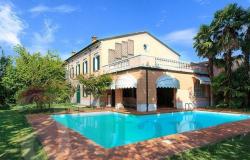Pictures by Gillian Price and Byron Russell
Bergamo Alta rests in the foothills of the Alps, the prealpi, a mere 45 minutes by train from Milano Centrale station. You can see the
town – an enticing glimpse of medieval walls, encircling a low range of hills – as you drive from Milan to Venice on the A4.
Rising up out of the sprawl of light industry and out-of-town shopping centres around Milan’s auto-strada network, you wouldn’t guess that here lies what the Rough Guides have called ‘one of Northern Italy’s loveliest city centres’.
However you arrive in Bergamo – train, plane or car – you first have to pass through Bergamo Bassa, the modern part of the town. It has its attractions, not least a cup of hot chocolate in one of the glitzy cafes around the Sentierone, the focal point of the passeggiata on a Saturday evening.
However, if time is limited it’s better to press on and head for the hills and the medieval quarter of Bergamo Alta, which is what you’ve come to see.
Let the train take the strain
 The best way by far is to go to the top of Viale Vittorio Emanuele and take the little funicular railway; it trundles up past terraced gardens and smart 18th-century villas, finally disappearing under those thick Venetian walls to emerge in the old town.
The best way by far is to go to the top of Viale Vittorio Emanuele and take the little funicular railway; it trundles up past terraced gardens and smart 18th-century villas, finally disappearing under those thick Venetian walls to emerge in the old town.
If you speak Italian you’ll also pick out the impenetrable local dialect, Bergamasco, for now you’re in Berghem de sura (upper Bergamo) – a proud, rich enclave that in the 16th century was renowned for being a law unto itself.
Once a Venetian stronghold, the town was one of Garibaldi’s famous Città dei Mille, contributing troops to the thousand Red Shirts that helped put an end to Franco-Austrian domination.
The bergamaschi are a tough mountain people, fiama de rar, sòta la sènder brasca (‘rarely fiery on the surface, but scalding ash beneath’ – Loris Capovilla, Pope John’s secretary).
Having refreshed yourself with an espresso or spremuta, you can stroll up the paved Via Gombito, along the gully of a canyon made up of tall 16th-century townhouses. Duck down a side alley, and you’ll emerge by a large 18th-century open washroom, where in times ‘BZ’ (Before Zanussi) the women would congregate to pound their linen clean.
”The most beautiful place on earth”
 At the weekend, the little streets heave with throngs of Milanese taking the air, but Bergamo doesn’t suit crowds. Come on a
At the weekend, the little streets heave with throngs of Milanese taking the air, but Bergamo doesn’t suit crowds. Come on a
weekday and the place will pretty much belong to you and the locals, which is how it should be.
Carry on down Via Gombito and suddenly, unexpectedly, you burst into Bergamo’s glory, the Piazza Vecchia, which the writer Stendahl once dubbed ‘the most beautiful place on earth’.
This may be an exaggeration, but it’s certainly a very fine square, backed by the fancy arches and columns of the civic library on one side and the rather forbidding Palazzo della Ragione (with a nice tower to climb) on the other.
On the other side of the piazza, passing the small covered square below the Palazzo where condemned criminals were put on display in ages past, you come to the Capella Colleoni. This striking building, with its spectacular multicoloured façade, was commissioned by the knight-mercenary Bartolommeo Colleoni as a mausoleum for himself and his young daughter Medea in the 1470s.
According to legend, Colleoni had an extra and quite unique personal feature (check out coglioni in the dictionary) which is reproduced on some of the putti and on his own coat-of-arms, polished by countless luck-seekers at the entrance to the chapel itself.
Four and Twenty Blackbirds
 It’s lunch time. Begin with a local aperitivo – a sparkling Berlucchi or Carlo Zadra, or a simple Valcalepio Rosso – at Cozzi’s, the renowned wine bar in Via Colleoni, and then head off to one of Città Alta’s many restaurants. On the way, look closely in the windows of the numerous patisseries and bakers for a yellow confection topped by small chocolate birds.
It’s lunch time. Begin with a local aperitivo – a sparkling Berlucchi or Carlo Zadra, or a simple Valcalepio Rosso – at Cozzi’s, the renowned wine bar in Via Colleoni, and then head off to one of Città Alta’s many restaurants. On the way, look closely in the windows of the numerous patisseries and bakers for a yellow confection topped by small chocolate birds.
This is the local speciality – polenta e osei, polenta with songbirds baked whole, beaks and all – which is replicated in marzipan for children and the squeamish.
Bergamo has its own pasta specialities, such as casoncei (casoncelli), crescent-shaped ravioli served with butter-fried sage, pancetta and garlic. But really, Bergamasco gastronomy is all about polenta.
The city is the centre of polenta eating – other Italians teasingly refer to the inhabitants as polentoni – and offers many pleasures for
those who don’t worry (or care) about their waistline.
Best of these, at least for me personally, is polenta taragna, which takes yellow polenta and mixes it with cheese and butter.
Top that with sausages (salsiccia), local funghi porcini or rabbit stew and you have a hearty meal that will keep out the worst of the winter cold as you step outside – if you can actually get up from the table, that is. Luckily there’s ample opportunity to walk it off, because you’re only half way up Bergamo’s hills.









